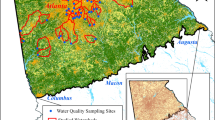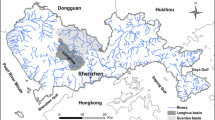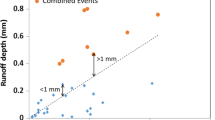Abstract
Urban stormwater quality is multifaceted and the use of a limited number of factors to represent catchment characteristics may not be adequate to explain the complexity of water quality response to a rainfall event or site-to-site differences in stormwater quality modelling. This paper presents the outcomes of a research study which investigated the adequacy of using land use and impervious area fraction only, to represent catchment characteristics in urban stormwater quality modelling. The research outcomes confirmed the inadequacy of the use of these two parameters alone to represent urban catchment characteristics in stormwater quality prediction. Urban form also needs to be taken into consideration as it was found have an important impact on stormwater quality by influencing pollutant generation, build-up and wash-off. Urban form refers to characteristics related to an urban development such as road layout, spatial distribution of urban areas and urban design features.



Similar content being viewed by others
References
APHA (2005) Standard methods for the examination of Water and Wastewater. American Public Health Association, Washington
AS/NZS 5667.1 (1998) Water Quality-Sampling Part 1: Guidance on the design of sampling programs, sampling techniques and the preservation and handing of samples. Australian/New Zealand Standard
Brabec E (2009) Imperviousness and land use policy: toward an effective approach to watershed planning. J Hydrol Eng 14(4):425–433
Cheng S, Lee C, Lee J (2010) Effects of urbanization factors on model parameters. Water Resour Manag 24(4):775–794
DecisionLab (2000) Decision Lab 2000 Executive Edition. Visual Decision Inc., Montreal
Gaddis E, Voinov A (2010) Spatially explicit modelling of land use specific phosphorus transport pathways to improve TMDL load estimates and implementation planning. Water Resour Manag 24(8):1621–1644
Goonetilleke A, Thomas E, Ginn S, Gilbert D (2005) Understanding the role of land use in urban stormwater quality management. J Environ Manage 74:31–42
Guo J, Urbonas B (1996) Maximized detention volume determined by runoff capture ratio. J Water Resour Plann Manag 122(1):33–39
Keller HR, Massart DL, Brans JP (1991) Multicriteria decision making: a case study. Chemometr Intell Lab Syst 11:175–189
Kostarelos K, Khan E, Callipo N, Velasquez J, Graves D (2011) Field study of catch basin inserts for the removal of pollutants from urban runoff. Water Resour Manag 25(4):1205–1217
Lee SW, Hwang SJ, Lee SB, Hwang HS, Sung HC (2009) Landscape ecological approach to the relationship of land use patterns in watersheds to water quality characteristics. Landscape Urban Plann 92:80–89
Novotny V, Olem H (1994) Water quality: prevention, identification and management of diffuse pollution. Van Nostrand Reinhold, New York
Author information
Authors and Affiliations
Corresponding author
Rights and permissions
About this article
Cite this article
Liu, A., Goonetilleke, A. & Egodawatta, P. Inadequacy of Land Use and Impervious Area Fraction for Determining Urban Stormwater Quality. Water Resour Manage 26, 2259–2265 (2012). https://doi.org/10.1007/s11269-012-0014-4
Received:
Accepted:
Published:
Issue Date:
DOI: https://doi.org/10.1007/s11269-012-0014-4




